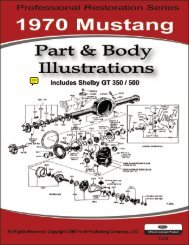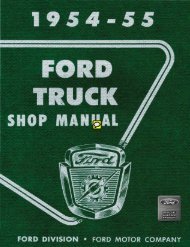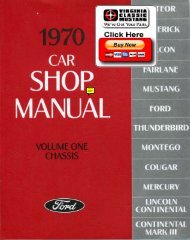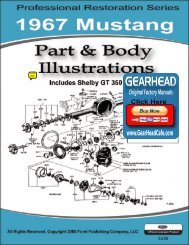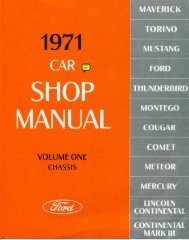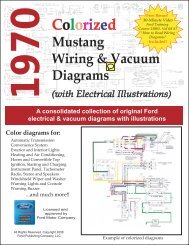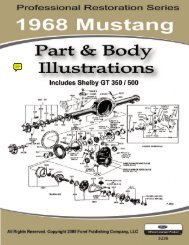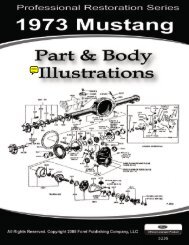DEMO - 1965 Ford Truck Shop Manual - ForelPublishing.com
DEMO - 1965 Ford Truck Shop Manual - ForelPublishing.com
DEMO - 1965 Ford Truck Shop Manual - ForelPublishing.com
Create successful ePaper yourself
Turn your PDF publications into a flip-book with our unique Google optimized e-Paper software.
2-6 GROUP 2 - BRAKES<br />
In either of the foregoing tests,<br />
leakage in excess of 1-inch soap bubble<br />
in three seconds indicates a defective<br />
governor.<br />
Coat the entire governor with soap<br />
suds to detect diaphragm, gasket, and<br />
cap screw leakage. No leakage is permissible.<br />
Reservoir Safety Valve. Coat the<br />
end of the safety valve with soap<br />
suds. Leaks causing not more than a<br />
3-inch soap bubble in three seconds<br />
are permissible.<br />
DIAGNOSIS GUIDE—AIR SUPPLY<br />
AIR PRESSURE BELOW<br />
NORMAL<br />
AIR PRESSURE RISES<br />
ABOVE NORMAL<br />
CONTINUOUS OR<br />
INTERMITTENT<br />
COMPRESSOR KNOCKS<br />
SAFETY VALVE<br />
"BLOWS-OFF"<br />
EXCESSIVE OIL OR WATER<br />
IN THE BRAKE SYSTEM<br />
SYSTEM<br />
Defective air gauge.<br />
Compressor worn out.<br />
Compressor discharge valve leakage.<br />
Slipping <strong>com</strong>pressor drive belt.<br />
Open reservoir drain cock.<br />
Excessive leakage at lines and fittings<br />
to reservoir tank.<br />
Defective or improperly adjusted<br />
governor.<br />
Compressor unloading valves stuck<br />
closed.<br />
Restriction in the passage between<br />
the governor and the <strong>com</strong>pressor unloading<br />
mechanism.<br />
Defective air gauge.<br />
Loose drive pulley.<br />
Worn or burned out <strong>com</strong>pressor<br />
bearings.<br />
Governor "cut-out" setting adjusted<br />
too high.<br />
Failure to drain the reservoirs at<br />
regular intervals.<br />
Low engine speed.<br />
Excessive carbon in the <strong>com</strong>pressor<br />
head or discharge line.<br />
Clogged <strong>com</strong>pressor air strainer.<br />
Defective or improperly adjusted<br />
governor.<br />
Compressor inlet valves stuck<br />
closed.<br />
Excessive clearance at the <strong>com</strong>pressor<br />
unloading valves.<br />
Leak at <strong>com</strong>pressor unloading piston<br />
seal.<br />
Carbon deposits in cavities beneath<br />
unloading piston and passages<br />
in the <strong>com</strong>pressor cylinder head.<br />
Excessive carbon deposits in the<br />
<strong>com</strong>pressor cylinder head.<br />
Above normal system pressure.<br />
Defective or improperly adjusted<br />
safety valve.<br />
Worn <strong>com</strong>pressor piston rings.<br />
Dirty <strong>com</strong>pressor air filter.<br />
AIR-HYDRAULIC BRAKES<br />
The trouble diagnosis procedures<br />
given here apply only to the booster<br />
unit and the applicable air system<br />
<strong>com</strong>ponents.<br />
First make the trouble diagnosis<br />
checks outlined under "Hydraulic<br />
Brakes" and "Air Supply System."<br />
Then perform the tests outlined in the<br />
following paragraphs.<br />
OPERATING TESTS<br />
Air Discharge Test. With the air<br />
pressure at 90 psi, depress the brake<br />
pedal several times and listen for air<br />
discharge as the pedal is released.<br />
Rapid release of air pressure indicates<br />
that the booster unit is operating.<br />
If no air discharge is heard, the<br />
booster control valve is defective or<br />
the connecting lines are restricted.<br />
Air Leak Test. Operate the engine<br />
until the air pressure builds up to 90<br />
psi. Stop the engine and watch the<br />
pressure gauge. If the air pressure<br />
drops more than 5 pounds in 15 seconds,<br />
check for internal leaks in the<br />
system, particularly at hose or pipe<br />
connections, a defective valve or piston<br />
in the booster, a defective air<br />
gauge (registering incorrectly), or<br />
leaking governor or <strong>com</strong>pressor discharge<br />
valves.<br />
Hydraulic Pressure Test. Connect<br />
a hydraulic pressure gauge (capable<br />
of reading at least 1200 psi pressure)<br />
to a bleeder screw opening at one of<br />
the brake cylinders.<br />
Remove the lubrication pipe plug<br />
from the rear of the booster body<br />
assembly and connect an air pressure<br />
test gauge at this point. Apply the<br />
brakes until approximately 60 psi is<br />
registered on the air gauge. Note the<br />
reading on the hydraulic pressure<br />
gauge. Hydraulic pressure should be<br />
950 to 1100 psi when air pressure is<br />
at 60 psi. If air pressure is higher or<br />
lower than 60 psi, hydraulic pressure<br />
will be proportionately higher or<br />
lower than 950 to 1100 psi.<br />
Hold the brakes in the fully applied<br />
position for at least one minute.<br />
Note the reading on the hydraulic<br />
pressure gauge. A low pressure reading,<br />
or a drop in pressure indicates<br />
leakage in the booster unit or in the<br />
other hydraulic system <strong>com</strong>ponents.<br />
Booster Test. With the air pressure<br />
at 90 psi, depress the brake pedal.<br />
Measure and record the distance<br />
from the pedal to the floor.<br />
Release the pedal and bleed all the<br />
air from the system. Depress the<br />
pedal, and again measure the distance<br />
from the pedal to the floor. The<br />
second measurement should be approximately<br />
Vi inch more than the<br />
dimension obtained with the booster<br />
system operating under air pressure.<br />
If there is no noticeable difference in<br />
the measurements, the booster is defective.




